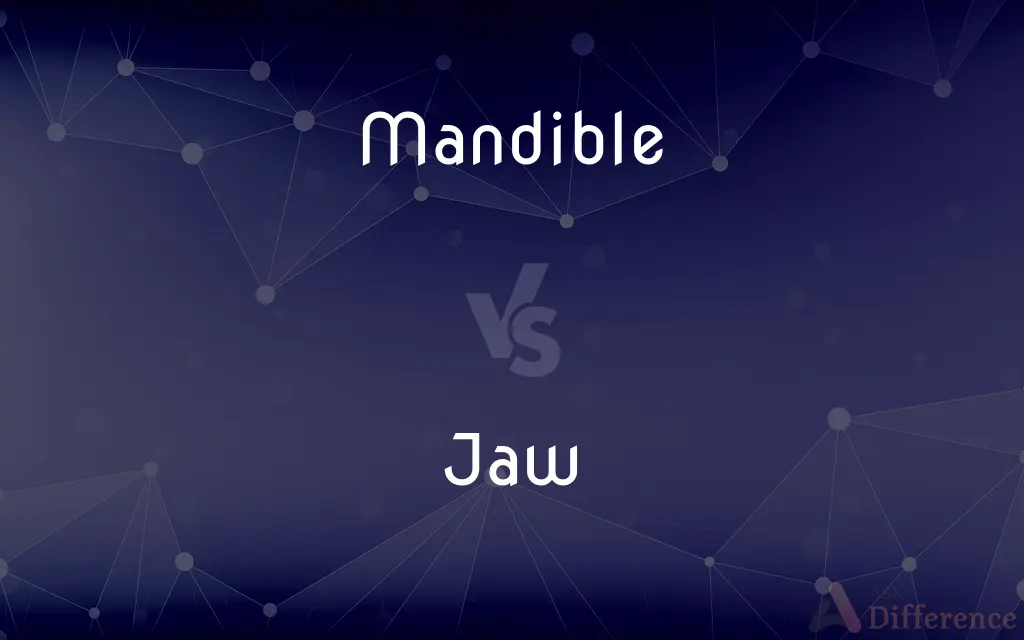Mandible vs. Jaw — What's the Difference?
By Fiza Rafique & Urooj Arif — Updated on April 8, 2024
The mandible refers specifically to the lower jawbone, crucial for chewing and speech, while "jaw" describes the entire structure, including both the upper and lower parts.

Difference Between Mandible and Jaw
Table of Contents
ADVERTISEMENT
Key Differences
The mandible, or lower jawbone, is the only movable bone of the skull, playing a key role in biting, chewing, and articulating speech. It supports the lower teeth and provides attachment points for muscles involved in opening and closing the mouth. In contrast, the term "jaw" encompasses both the upper and lower parts of the mouth's structure. The upper jaw, or maxilla, is fixed and houses the upper teeth, contributing to the formation of the roof of the mouth, the floor of the orbit, and the sides of the nasal cavity.
The mandible is a single U-shaped bone that articulates with the skull at the temporomandibular joints, allowing for the up-and-down movement necessary for chewing and talking. The jaw, on the other hand, refers to the combined framework of bones, including the mandible and maxilla, that supports all of the teeth and provides the mechanical basis for mouth movements.
The mandible originates from the first pharyngeal arch and undergoes ossification to form its bone structure in the fetus. The jaw's development is more complex, involving the fusion of multiple bone plates in the maxilla and the growth of the mandible to form a functional skeletal unit capable of handling the mechanical forces of eating and speaking.
In terms of dental health, issues with the mandible can include misalignment, fractures, and temporomandibular joint disorders, affecting the lower part of the mouth specifically. Jaw problems, however, can encompass a broader range of conditions affecting both the upper and lower parts, including orthodontic issues, joint dysfunction, and congenital anomalies affecting the overall structure and function of the mouth.
Despite these differences, both the mandible and the jaw are integral to facial anatomy, contributing to the aesthetics of the face, the efficiency of the digestive system, and the clarity of speech. The health and functionality of both are vital for overall well-being, emphasizing the interconnectedness of the structures within the human skull.
ADVERTISEMENT
Comparison Chart
Definition
The lower jawbone, movable and houses the lower teeth.
The entire structure of the upper and lower jaw, including all associated bones.
Components
Single bone (mandible).
Includes both the mandible (lower jaw) and maxilla (upper jaw).
Movement
Movable, articulates with the skull at temporomandibular joints.
Includes both movable (mandible) and fixed (maxilla) parts.
Role in Chewing
Moves to facilitate biting and chewing.
Supports all teeth and provides mechanical basis for mouth movements.
Development
Originates from the first pharyngeal arch, undergoes ossification.
Involves the fusion of maxillary bone plates and growth of the mandible.
Compare with Definitions
Mandible
The bone forming the lower jaw.
The dentist examined the x-ray for fractures in the patient's mandible.
Jaw
Supports the facial muscles and teeth.
She clenched her jaw in frustration.
Mandible
A movable bone connected to the skull.
The snake can dislocate its mandible to consume large prey.
Jaw
Integral to facial aesthetics and function.
The sculpture captured the subject's jaw beautifully.
Mandible
Key in chewing and speech.
He couldn't speak clearly due to a mandible injury.
Jaw
Includes both upper and lower parts of the mouth structure.
The boxer suffered a heavy blow to his jaw.
Mandible
Only movable bone of the skull.
The mandible's unique mobility aids in complex mouth movements.
Jaw
Critical for eating and speaking.
Jaw pain can significantly impact daily life, making eating and speaking difficult.
Mandible
Houses the lower set of teeth.
Her mandible was strong and well-formed, indicative of good health.
Jaw
Affected by various orthodontic conditions.
Orthodontic treatment can realign the jaw to improve bite and smile.
Mandible
In anatomy, the mandible, lower jaw or jawbone is the largest, strongest and lowest bone in the human facial skeleton. It forms the lower jaw and holds the lower teeth in place.
Jaw
The jaw is any opposable articulated structure at the entrance of the mouth, typically used for grasping and manipulating food. The term jaws is also broadly applied to the whole of the structures constituting the vault of the mouth and serving to open and close it and is part of the body plan of humans and most animals.
Mandible
The jaw or a jawbone, especially the lower jawbone in mammals and fishes.
Jaw
Either of two bony or cartilaginous structures that in most vertebrates form the framework of the mouth and hold the teeth.
Mandible
The lower jaw of a vertebrate animal.
Jaw
The mandible or maxilla or the part of the face covering these bones.
Mandible
Either the upper or lower part of the beak in birds.
Jaw
Any of various structures of invertebrates that have an analogous function to vertebrate jaws.
Mandible
Any of various mouth organs of invertebrates used for seizing and biting food, especially either of a pair of such organs in insects and other arthropods.
Jaw
Either of two opposed hinged parts in a mechanical device.
Mandible
The jaw or a jawbone, especially the lower jawbone in mammals and fishes.
Jaw
Jaws The walls of a pass, canyon, or cavern.
Mandible
Either of the upper and lower segments of a bird's beak.
Jaw
Impudent argument or back talk
Don't give me any jaw.
Mandible
Any of various invertebrate mouthparts serving to hold or bite food materials.
Jaw
A conversation or chat.
Mandible
The bone, or principal bone, of the lower jaw; the inferior maxilla; - also applied to either the upper or the lower jaw in the beak of birds.
Jaw
To talk vociferously; jabber.
Mandible
The anterior pair of mouth organs of insects, crustaceaus, and related animals, whether adapted for biting or not. See Illust. of Diptera.
Jaw
To talk; converse.
Mandible
The lower jawbone in vertebrates; it is hinged to open the mouth
Jaw
One of the bones, usually bearing teeth, which form the framework of the mouth.
Jaw
The part of the face below the mouth.
His jaw dropped in amazement.
Jaw
A notch or opening.
Jaw
A notched or forked part, adapted for holding an object in place.
The jaw of a railway-car pedestal.
Jaw
One of a pair of opposing parts which are movable towards or from each other, for grasping or crushing anything between them.
The jaws of a vise; the jaws of a stone-crushing machine.
Jaw
(nautical) The inner end of a boom or gaff, hollowed in a half circle so as to move freely on a mast.
Jaw
Impudent, abusive or worthless talk.
Jaw
(slang) Axle guard.
Jaw
(snooker) The curved part of the cushion marking the entry to the pocket.
Jaw
(transitive) To assail or abuse by scolding.
Jaw
(intransitive) To scold; to clamor.
Jaw
To talk; to converse.
Jaw
(of a ball) To stick in the jaws of a pocket.
Jaw
(used in certain set phrases like jaw harp, jaw harpist and jaw's-trump)
Jaw
One of the bones, usually bearing teeth, which form the framework of the mouth.
Jaw
A notch or opening.
Jaw
The inner end of a boom or gaff, hollowed in a half circle so as to move freely on a mast.
Jaw
Impudent or abusive talk.
Jaw
To scold; to clamor.
Jaw
To talk idly, long-windedly, or without special purpose.
Jaw
To assail or abuse by scolding.
Jaw
The part of the skull of a vertebrate that frames the mouth and holds the teeth
Jaw
The bones of the skull that frame the mouth and serve to open it; the bones that hold the teeth
Jaw
Holding device consisting of one or both of the opposing parts of a tool that close to hold an object
Jaw
Talk socially without exchanging too much information;
The men were sitting in the cafe and shooting the breeze
Jaw
Talk incessantly and tiresomely
Jaw
Chew (food);
He jawed his bubble gum
Chew your food and don't swallow it!
The cows were masticating the grass
Jaw
Censure severely or angrily;
The mother scolded the child for entering a stranger's car
The deputy ragged the Prime Minister
The customer dressed down the waiter for bringing cold soup
Common Curiosities
Do mandible issues affect the entire jaw?
Issues with the mandible can impact overall jaw function and aesthetics, but specific problems are usually localized to the lower jaw.
Can the mandible move independently of the jaw?
The mandible is the only movable part of the jaw, allowing for the opening and closing of the mouth.
How are jaw and mandible related in dental health?
Dental health considers both the jaw and mandible for alignment, bite, and function, addressing issues that can affect either or both structures.
Can injuries to the jaw also involve the mandible?
Yes, injuries to the jaw can involve the mandible, especially since it is a critical component of the jaw's structure.
Is the upper jaw also called the mandible?
No, the upper jaw is known as the maxilla; the mandible refers only to the lower jawbone.
What role does the mandible play in facial structure?
The mandible defines the lower facial structure, influencing overall facial aesthetics and function.
What distinguishes the mandible from the jaw?
The mandible is the lower part of the jaw, specifically referring to the lower jawbone, while the jaw encompasses both the upper and lower structures of the mouth.
How does the mandible's development affect jaw alignment?
Proper development of the mandible is crucial for correct jaw alignment and the fit of the upper and lower teeth.
Can the jaw function properly without a healthy mandible?
A healthy mandible is essential for the full function of the jaw, particularly for chewing and speaking.
What is the significance of the temporomandibular joint in jaw movement?
This joint connects the mandible to the skull, allowing for the mobility necessary for mouth opening, chewing, and speaking.
Are there surgeries specific to the mandible or jaw?
There are surgeries specific to both, with mandibular surgeries focusing on the lower jaw and other procedures addressing broader jaw issues.
How do mandible and jaw issues impact speech?
Both can impact speech; mandible issues affect movement and articulation, while jaw problems can alter the spatial relations necessary for sound production.
What are common treatments for mandible and jaw issues?
Treatments can range from orthodontic interventions and physical therapy to surgical procedures, tailored to the specific condition and structure affected.
Is it common for orthodontic treatments to target both the mandible and jaw?
Yes, orthodontic treatments often target both to improve bite alignment and aesthetic balance.
How do dental professionals diagnose mandible vs. jaw issues?
Diagnosis involves clinical examination, imaging, and assessing symptoms, distinguishing between specific mandible problems and broader jaw conditions.
Share Your Discovery

Previous Comparison
Genius vs. Prodigy
Next Comparison
Jesus vs. HorusAuthor Spotlight
Written by
Fiza RafiqueFiza Rafique is a skilled content writer at AskDifference.com, where she meticulously refines and enhances written pieces. Drawing from her vast editorial expertise, Fiza ensures clarity, accuracy, and precision in every article. Passionate about language, she continually seeks to elevate the quality of content for readers worldwide.
Co-written by
Urooj ArifUrooj is a skilled content writer at Ask Difference, known for her exceptional ability to simplify complex topics into engaging and informative content. With a passion for research and a flair for clear, concise writing, she consistently delivers articles that resonate with our diverse audience.














































